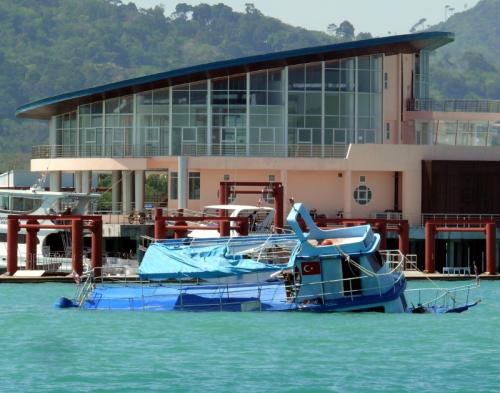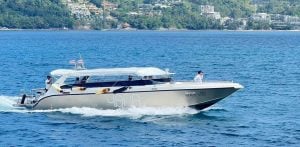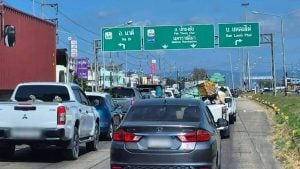Chalong Bay’s sunken dangers

PHUKET: After spending 5.8 million baht to install new moorings in Chalong Bay and at Ao Por, on Phuket’s east coast, the chief of the local Marine Office now says he needs more money to fix the moorings, which have sunk one boat and damaged at least three others.
The moorings in nautical terms are brand-new. They were dropped in the waters off Phuket 14 weeks ago – 200 in Chalong Bay and 100 at Ao Por.
Reports surfaced barely a month later that many of the new moorings in Chalong were not usable because the buoys that marked them had broken loose and disappeared. They broke loose, experienced yachties say, because the lines attaching them to the concrete blocks on the sea floor frayed due to improper tethering.
However, Phuket Marine Office chief Phuripat Theerakulpisut this week rejected accusations that the tethers were “cheap” and “ineffective”. Instead, he blamed the broken lines on “sabotage”.
He did not explain what might have motivated the sabotage.
“Some people have cut some of the moorings. I have no idea who they are. I am trying to find out,” he said.
“Some of the moorings broke because they have been used for a while [since November 29]. If we are going to fix them, we need the budget – but I have yet to draw up any budget proposal,” Mr Phuripat explained.
Further, Mr Phuripat said he was not convinced that the situation required urgent action just yet. “I am now thinking about it,” he admitted to the Phuket Gazette on Wednesday.
With no buoys to mark them, many of the moorings, lurking just beneath the surface, now present a serious danger to boats and their crews and passengers, according to several local yachtsmen, each with more than a decade of experience in navigating Phuket’s waterways.
The danger of unmarked mooring blocks in shallow waters became clear two weeks ago, on February 26, when the tour boat “Booze Cruise” collided at low tide with an unmarked block in the middle of the approach channel to Chalong Pier (story here).
The collision rammed a hole in the boat’s hull, causing it to sink quickly. The daytrippers on board jumped into the sea and were rescued by onlookers.
Not two hours later, a speedboat carrying tourists from Chalong Pier to a popular island resort off Phuket struck an unmarked mooring in the same location.
“It could be the same unmarked mooring, but we’re not sure,” the speedboat captain told the Gazette.
The speedboat’s gearbox was damaged, forcing the captain to gingerly guide the boat toward the marina under construction in the bay so the tourists could board another boat and continue their journey.
“We don’t know how much it will cost to fix. The boat is still in the repair yard,” the captain said.
Local yachtsmen have confirmed to the Gazette that “about a dozen” moorings were placed in the approach channel.
“About four of them are still marked by [mooring] buoys,” one yachtsman said.
“Where the remaining unmarked buoys are located is anyone’s guess,” he added.
Another concern raised by local yachtsmen whose vessels remain anchored in Chalong Bay is that many of the moorings were placed too close together, raising the prospect of boats colliding while tied to them.
One long-term expat sailor in provided a list of costs to the Gazette showing that his yacht suffered damage of more than 118,000 baht. His boat is still under repair, and cannot be used for charters until the repairs are complete.
Popular Phuket yachtsman Richard Spraggs, from New Zealand, paid with his life for a boat collision while at moored in the bay. He drowned in the early hours of January 25 while trying to reposition his yacht, which had drifted too close to another boat (story here).
Yet Mr Phuripat remains unmoved, the yachties say, by the growing list of calamities associated with the new moorings.
“Boat accidents in Chalong Bay are common. The bay is usually crowded with tourists and boats. It is one of the main piers from which to take a boat to many tourist attractions [in Phang Nga Bay],” he explained.
“As I told you before, what I really do not like are reckless boat drivers. They drive too fast and do not drive along the fairway [approach channel]. This is the main cause of boat accidents,” Mr Phuripat insisted.
Latest Thailand News
Follow The Thaiger on Google News:


























